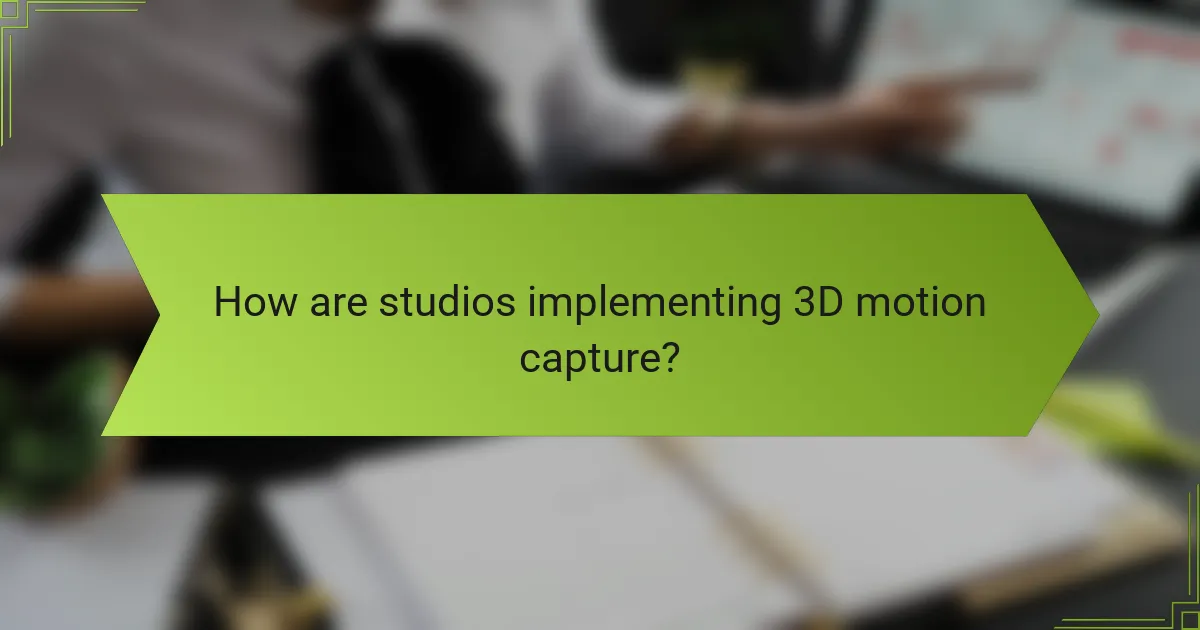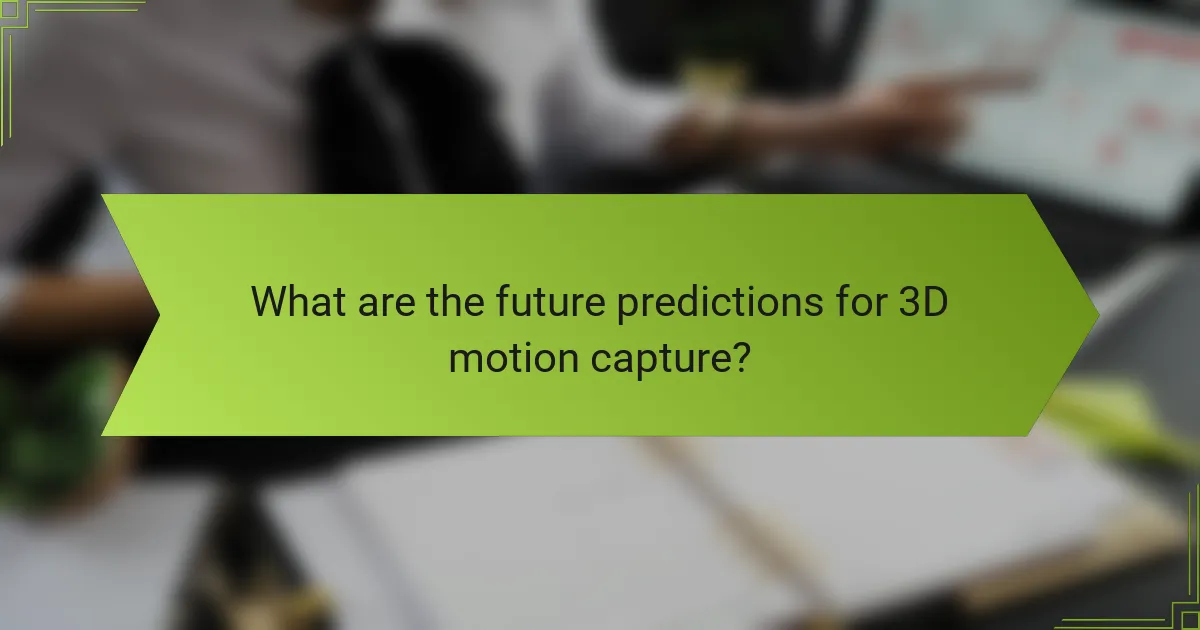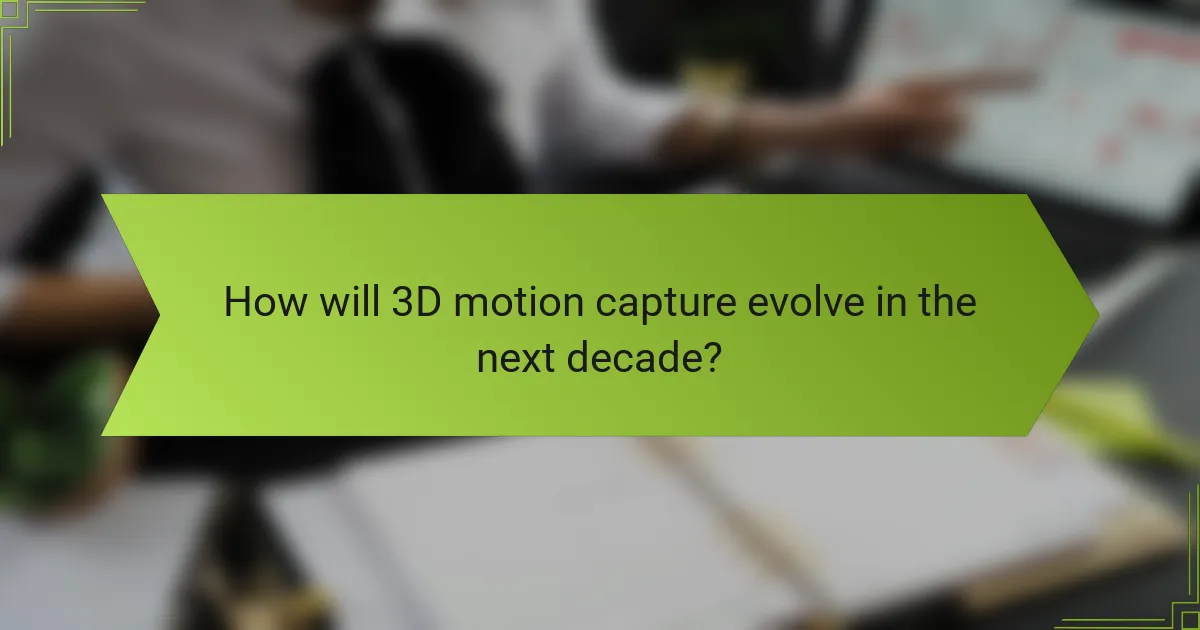3D motion capture is transforming the entertainment industry by providing unprecedented realism in animations and interactions across video games, films, and live performances. Recent innovations, such as markerless systems and AI-driven data processing, are enhancing the accuracy and efficiency of this technology, paving the way for more immersive experiences in virtual reality and beyond.

How is 3D motion capture transforming the entertainment industry?
3D motion capture is revolutionizing the entertainment industry by enabling more lifelike animations and interactions in video games, films, and live performances. This technology captures the movements of actors or objects and translates them into digital formats, enhancing the overall viewer experience.
Enhanced realism in video games
3D motion capture significantly boosts realism in video games by providing detailed character movements that mimic real-life actions. This technology allows developers to create more immersive environments where players can engage with lifelike characters, enhancing gameplay and emotional connection.
For example, games like “The Last of Us” and “Assassin’s Creed” utilize motion capture to deliver fluid animations that respond dynamically to player inputs. As a result, players experience a more authentic and engaging gaming experience.
Improved animation techniques in films
In the film industry, 3D motion capture has transformed animation techniques by allowing filmmakers to create realistic characters and scenes. This method captures subtle facial expressions and body movements, which can be translated into animated characters, making them more relatable and expressive.
Films such as “Avatar” and “The Jungle Book” showcase the power of motion capture in creating visually stunning and emotionally resonant characters. The technology enables filmmakers to blend live-action and CGI seamlessly, pushing the boundaries of storytelling.
Real-time performance capture for live events
Real-time performance capture is becoming increasingly popular in live events, allowing performers to interact with digital elements on stage. This technology enables the immediate translation of an actor’s movements into animated characters or visual effects, creating a unique and engaging experience for audiences.
For instance, concerts and theater productions are now incorporating motion capture to enhance live performances with dynamic visuals. This integration not only captivates audiences but also opens new creative avenues for artists and producers alike.

What are the latest innovations in 3D motion capture technology?
The latest innovations in 3D motion capture technology focus on enhancing accuracy, efficiency, and integration with other digital platforms. Key advancements include markerless systems, AI-driven data processing, and seamless integration with virtual reality environments.
Markerless motion capture systems
Markerless motion capture systems utilize advanced computer vision techniques to track human movement without the need for physical markers. This technology simplifies setup and reduces the time required for calibration, making it ideal for dynamic environments like film sets or live performances.
These systems often rely on multiple cameras and sophisticated algorithms to analyze body movements. They can capture a wide range of actions, from subtle gestures to complex dance routines, providing filmmakers and game developers with greater flexibility in capturing performances.
AI-driven data processing
AI-driven data processing enhances the efficiency of motion capture by automating the analysis and interpretation of captured data. Machine learning algorithms can quickly process large volumes of motion data, identifying patterns and refining the output to ensure high fidelity in character animations.
This innovation allows for real-time feedback during recording sessions, enabling artists to make adjustments on the fly. Additionally, AI can help in reducing noise and artifacts in the data, resulting in smoother and more realistic animations.
Integration with virtual reality
Integration with virtual reality (VR) is transforming how motion capture is utilized in the entertainment industry. By combining motion capture with VR, creators can immerse users in interactive experiences where their movements directly influence the virtual environment.

How are studios implementing 3D motion capture?
Studios are integrating 3D motion capture by utilizing advanced technologies that track and record the movements of actors in real-time. This data is then translated into digital models, enhancing the realism of animated characters and special effects in films and video games.
Case study: Weta Digital’s techniques
Weta Digital employs a combination of high-resolution cameras and sophisticated software to capture intricate movements. Their process often involves placing markers on actors, which are tracked by multiple cameras to create a detailed 3D representation of their performance.
A notable example is their work on “Avatar,” where they used motion capture to bring alien characters to life, blending live-action performances with CGI seamlessly. This technique allows for a high degree of emotional expression and realism in animated characters.
Case study: Industrial Light & Magic’s projects
Industrial Light & Magic (ILM) has pioneered the use of motion capture in blockbuster films, notably in the “Star Wars” franchise. They utilize a range of technologies, including facial capture systems, to enhance character animations and create lifelike interactions between digital and live-action elements.
In projects like “Rogue One,” ILM combined traditional filmmaking with motion capture to recreate iconic characters, ensuring that the performances resonate with audiences. Their approach emphasizes the importance of actor input, allowing for more nuanced and engaging character portrayals.

What are the challenges of adopting 3D motion capture?
Adopting 3D motion capture presents several challenges, primarily related to costs and technical expertise. These barriers can hinder the integration of this technology in various entertainment sectors, affecting production timelines and budgets.
High initial investment costs
The high initial investment costs associated with 3D motion capture can be a significant barrier for many studios and independent creators. Equipment, software licenses, and facility upgrades can easily run into the tens of thousands of dollars, making it a substantial financial commitment.
For instance, a basic motion capture setup may require cameras, sensors, and specialized software, which can collectively exceed USD 50,000. This upfront cost can be daunting, especially for smaller production companies or independent filmmakers.
Technical skill requirements
Implementing 3D motion capture effectively demands a certain level of technical skill. Professionals must be trained in using the equipment, understanding the software, and managing data processing, which can take time and resources to develop.
Moreover, the learning curve can be steep for those new to the technology. Studios may need to invest in training programs or hire experienced personnel, further increasing operational costs. Ensuring that the team is proficient in motion capture techniques is crucial for achieving high-quality results.

What are the future predictions for 3D motion capture?
The future of 3D motion capture is set to be characterized by greater accessibility, enhanced technology, and innovative applications in the entertainment industry. As tools become more user-friendly and affordable, a wider range of creators will be able to leverage motion capture for storytelling and gameplay.
Increased accessibility for indie developers
Indie developers are expected to benefit significantly from advancements in 3D motion capture technology. Affordable software and hardware solutions will allow smaller studios to create high-quality animations without the need for extensive resources. Platforms like Unity and Unreal Engine are integrating motion capture tools, making it easier for developers to implement realistic character movements.
Additionally, community-driven resources and tutorials are emerging, providing indie developers with the knowledge to utilize motion capture effectively. This democratization of technology will likely lead to a surge in innovative indie games and films that push creative boundaries.
Advancements in mobile motion capture
Mobile motion capture technology is rapidly evolving, enabling users to capture movements using smartphones and tablets. This shift allows for on-the-go recording, making it easier for creators to gather data in various environments without expensive equipment. Companies are developing apps that utilize the built-in sensors of mobile devices to provide accurate motion tracking.
As mobile motion capture becomes more sophisticated, it will open up new possibilities for real-time animation and augmented reality experiences. Developers can expect to see improvements in accuracy and ease of use, making mobile solutions a viable option for both professional and amateur creators alike.

How will 3D motion capture evolve in the next decade?
In the next decade, 3D motion capture technology is expected to become more accessible and integrated into various entertainment sectors, enhancing realism and interactivity. Innovations will likely include improved accuracy, reduced costs, and seamless integration with other technologies like virtual and augmented reality.
Integration with artificial intelligence
The integration of artificial intelligence (AI) into 3D motion capture will revolutionize how data is processed and utilized. AI can analyze motion data in real-time, allowing for immediate adjustments and enhancements, which can significantly streamline production workflows.
For example, AI algorithms can predict and fill in missing motion data, making it easier to create fluid animations without extensive manual corrections. This capability can reduce the time spent on post-production, potentially cutting it down by significant margins.
When adopting AI in motion capture, consider the balance between automation and human oversight. While AI can enhance efficiency, human creativity and direction remain crucial to ensure the final output aligns with artistic visions.
